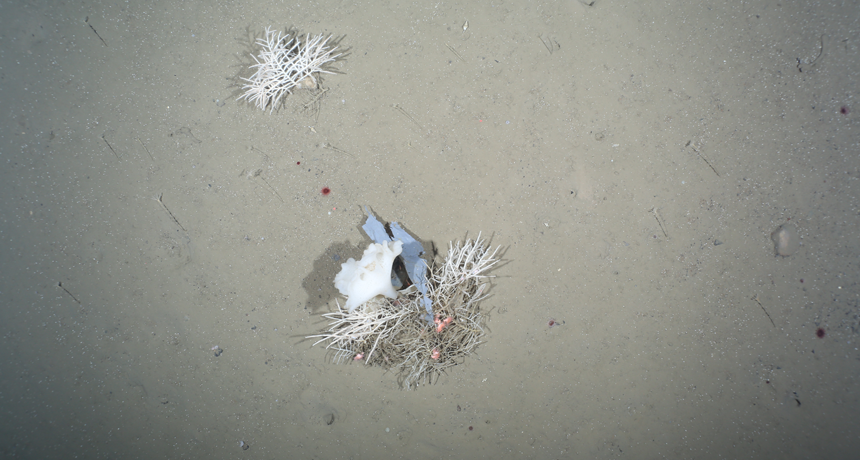Deep-sea dump: Trash is collecting on the Arctic seafloor
One part of the ocean floor has 20 times more litter than a decade ago

A piece of blue plastic litter rests in the branches of a sea sponge. It’s a portion of the Arctic seafloor where small pink shrimp also have taken refuge. (The flower-like animal is a sea lily.)
Melanie Bergmann
Share this:
- Share via email (Opens in new window) Email
- Click to share on Facebook (Opens in new window) Facebook
- Click to share on X (Opens in new window) X
- Click to share on Pinterest (Opens in new window) Pinterest
- Click to share on Reddit (Opens in new window) Reddit
- Share to Google Classroom (Opens in new window) Google Classroom
- Click to print (Opens in new window) Print
Researchers and fishing crews have found a lot of trash floating in the world’s oceans over the past few decades. That trash has even shown up in the remote Arctic Ocean. Now a study shows there is also trash deep down on the Arctic seafloor. Though few people live nearby, researchers found plastic bags, shards of glass and fishing nets. And the litter problem is getting worse.
“Many studies look at litter on the sea surface. We wanted to look at the deep seafloor,” says Melanie Bergmann. She’s a deep-sea biologist with the Alfred Wegener Institute in Bremerhaven, Germany. Bergmann and her colleagues also wondered how that ocean trash might be changing over time. “We wanted to know if it’s getting worse,” she says.
And the short answer: Yes!
Each year from 2002 to 2014, Bergmann and her team took pictures of the seafloor at two places in the Fram Strait. This is a narrow stretch of the Arctic Ocean between Greenland and Svalbard, a Norwegian island group in the far North. The researchers lowered cameras down to 2,500 meters (about 1.5 miles), then towed them behind their research boat. Those cameras snapped photos every 30 seconds.
To date, the scientists have taken 7,058 photos. Those pictures turned up 89 pieces of litter.
That may not seem like a lot. But it’s about the same concentration of deep-sea trash found far to the south, off the coast of Portugal. This surprised the scientists because there are far fewer people living in the Arctic than in Portugal. With so many fewer people there to litter, they had expected to see little trash on the Arctic floor.
There are also worrying signs that the trash there is growing. At one location, Bergmann’s group found 20 times more litter in 2014 than 10 years earlier.
Where did the trash come from?
Bergmann suspects that the bits of glass they saw came from boats. A warming climate is melting sea ice in the far North. That means it’s easier for ships carrying goods or people to find a clear path. And indeed, shipping traffic there has been increasing.
People on those boats are probably dumping their garbage in the water, either on purpose or accidentally, Bergmann thinks. Because glass is denser than water, it quickly sinks to the bottom. So do dense pieces of plastic.
Lighter bits of plastic travel to the Fram Strait on ocean currents from the South. These currents carry water northward from the coastlines of countries such as the United Kingdom, the Netherlands and Germany. Light-weight plastic floats at first. Over time, however, “algae and other critters grow on it,” Bergmann notes. Eventually, they weigh the plastic down until it sinks.
Still other plastic pieces likely ride currents into the area from north of the Fram Strait. Bergmann thinks this plastic was trapped in the far North in the winter. When spring comes and the ice begins to melt, it releases all of that plastic trash. Currents can then carry it into the Fram Strait.
Most researchers thought ice up North would be a barrier to floating trash. “In years when we had more ice,” Bergman suspected that “we’d have less litter.” Her data now show “the opposite.”

Life in plastic
Bergmann worries how all this debris in the deep Arctic may affect wildlife. Other studies have shown that ropes or bags can entangle birds, fish, seals and even reindeer. Seabirds and fish sometimes swallow bags and other plastic bits. With their stomachs full, they will stop eating real food. Sometimes the plastic blocks their digestive tracts so that even if they wanted to eat, they couldn’t. In time, those birds and fish starve.
Trash on the ocean floor can be just as deadly. This region is home to all sorts of creatures, including worms, sponges, shrimps, sea cucumbers and sea anemones.
“If a plastic bag falls on top of them, the oxygen and food trickling down from the surface will be reduced,” says Bergmann. The animals might then die. And this could lower the amount and diversity of life on the seafloor.
To investigate the impacts of seafloor trash, her team started an experiment two years ago. They placed plastic bags and other plastic debris on some sea sponges in the area. This summer, they plan to go back and see how those animals have fared.
“Sponges are like trees, which attract birds and insects on land. On the seafloor, sponges attract little shrimps and sea anemones,” Bergmann observes. So smothering those sea sponges, she worries, may harm biodiversity. That’s what her team’s experiment will be looking at.
Marcus Eriksen is an environmental scientist with the 5 Gyres Institute in Los Angeles, Calif. This group looks for solutions to problems caused by plastic trash. Bergmann’s study shows once again that people need to use less plastic, he says.
Eriksen’s group is trying to get companies to reduce their use of such long-lived materials. “All of us, including the industries that make plastic products, are responsible for the problem,” he says.







